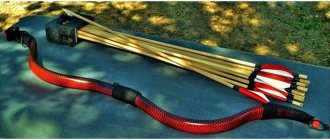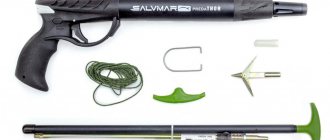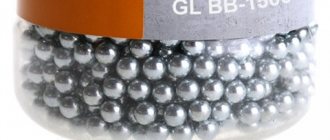High-quality archery cannot be achieved without properly selected arrows. Today there are many types of such projectiles on the market - for solving entertainment, sports or hunting problems. For ordinary people and beginners, the visual difference between them is almost invisible, but with practical use the differences become quite obvious. Therefore, it is good to be able to understand the issue of choosing the right quality archery kit.
General information
An arrow is a type of projectile fired from a bow, in the form of a thin rod with narrow feathers (blades) and a tip.
Areas of application are:
- sport;
- historical re-enactments and entertainment;
- hunting;
- for children.
Main components:
- tip - the front part that hits the target;
- shaft - a rod connecting the tip with the plumage and shank;
- plumage - blades made of feathers or plastic (usually three), stabilizing flight;
- shank - a fixing recess into which the bowstring is inserted.
Shaft material
The shaft is the main part of the arrow to which all related accessories will be attached. The following parameters are taken into account - the length of the shaft (it depends on the stretch of the bowstring) and the material from which it is made.
Tree
A traditional type of material used by our ancestors since the invention of the first bow. The advantage is the versatility of such arrows: they are suitable for both recreational shooting and hunting small game, and have good quality characteristics. In addition, they are cheaper than other types of arrows and will be a good choice for those who are just taking their first steps in shooting. These projectiles are also used in traditional bows and look authentic. But it should be borne in mind that wooden arrows are not as strong as products made from modern artificial materials, and therefore are not suitable for powerful sports bows.
Aluminum
The material most often used to make arrows. We are loved by manufacturers for the optimal combination of rigidity and light weight. This is the best option for a wide variety of shooting types. Suitable for both simple target shooting and hunting. The downside is that they can bend over time if used frequently. But the cost of such arrows is quite low, so buying them will not hurt your pocket.
Fiberglass
Modern composite material, relatively inexpensive, but high quality. It produces geometrically balanced, neat arrows. But their strength is lower than that of aluminum, so such projectiles are suitable only for a narrow range of tasks.
Carbon
The most durable and high-quality arrows currently on the market. Carbon, like fiberglass, is a composite material, but, unlike it, it is more expensive and has higher strength and low weight. Carbon arrows are balanced, strong, and at the same time very light, so they are suitable for a wide variety of purposes. This is ideal for use in professional sports shooting.
Varieties
By tip type
- Bullet-shaped - for sport or hunting in the form of a bullet. The diameter is less than or equal to the thickness of the shaft to improve aerodynamic properties and prevent jamming.
- Combined/field – for sports or hunting with a pointed and sharpened bullet shape. They have more destructive properties, but with better safety of the target due to less deep penetration.
- Blunt or flat - for catching small game with a blunt end. Some have a rubber head with a diameter larger than the shaft and small spikes.
- Shockers - for hunting or training shooting with blunt tips and small hooks. As a result of catching on the ground, grass or leaves, the arrow turns over, which greatly facilitates the search.
- Fishing - for fishing (bowfishing) with a pointed end and a built-in spike.
- Broadheads - only for hunting with a flat, wide and sharp blade that inflicts severe wounds.
According to shaft material
1. Wooden - the basic base of the shaft for children's bows or models with a low tension force. Typically made in a disposable version using feathers instead of durable plastic blades. They are distinguished by their low price and accessibility for traditional archers.
2. Aluminum - for beginner archers. Typically made hollow to reduce weight and vary in cost depending on the manufacturer. Easily cut to size, but heavier than carbon ones with less distance and flight speed. They also break more often and harder, without splintering.
3. With an alloy core coated with carbon - for trophy hunters and professional athletes. The production uses a lightweight material on which carbon fiber is applied to increase rigidity.
4. Carbon - for everyone who wants to get into archery. The shaft is made of carbon fiber, which is not as stiff as aluminum and is lighter in weight.
5. Fiberglass (fiberglass) - for toys and inexpensive weapons with low tension.
By type of plumage
The main purpose is to introduce rotation and stabilize flight. As a rule, all arrows have three feathers, evenly spaced from the edge. When installing four feathers with a flat trajectory, more rotation is achieved.
- Natural - turkey flight feathers are used, which get wet in the rain and are not as durable as plastic ones. They are characterized by increased flexibility in contact with the bow rest and handle.
- Plastic is more rigid than feather and waterproof.
- Spiral - Curved to resemble fan blades for rotation in flight and increased stability. Typically used with recurve bows in sporting competitions by Olympians or advanced archers.
By shank type
- Glued to the end.
- Glued into the recess.
- Screwed into the shaft.
- With fastening devices.
Arrow structure
Typically, the structure includes:
- base (tube or shaft);
Arrow: structure. - tip;
- plumage (natural or plastic);
- shank.
Now let's look at each of these elements in more detail.
Base
Archers select a specific type of arrow in accordance with the season, type of bow and their own taste.
- The base can be made of fiberglass, carbon, aluminum or wood.
- In this case, you need to distinguish between fiberglass and carbon. Arrow for a bow.
- Wooden arrows are relevant when shooting with traditional bows.
- The base has markings, thanks to which you can find out about the model, rigidity and weight of the structure.
- The base has a diameter in the range of 4.5-10 mm.
- The wall thickness can reach 0.5 mm.
Tip
Tips can be used for hunting or sporting purposes.
- Sports options are used indoors. As a rule, they have a bullet-shaped, streamlined shape. They can be glued into a tube or screwed into place.
- Hunting ones can be solid or streamlined. The latter are equipped with a blunt end that prevents damage to the skin.
Hunting arrowheads.
Plumage
The tail affects the degree of stabilization of the projectile during flight. This is especially felt when shooting at long distances.
- The plumage can be natural, plastic or rubber.
- The first option is recommended for wooden and “winter” type arrows.
- For “summer” sports ones you will need plastic or rubber tails.
- Natural will slow down the projectile during flight.
Arrow fletchings.
Shank
The shank is the element that secures the projectile to the bowstring. In addition, it transmits the force of the bowstring. The shank is plastic and differs in the type of fit.
- Some are glued, while others are directly mounted on the shaft.
- There are also arrow shanks that are attached using adapters.
Criterias of choice
In order not to make mistakes when choosing, you should pay attention to the advice of professionals and select arrows to suit your parameters and compound bow. The main characteristics for hunting bow shells are:
- length;
- weight;
- aerodynamic stability;
- rigidity.
Often, to make selection easier, manufacturers offer instructions in tabular form depending on the ratio of arrow length to arm span.
| Arm span, cm | 155 | 160 | 165 | 170 | 175 | 180 | 185 | 190 | 195 |
| Boom length, cm | 58 | 61 | 63 | 64.5 | 66 | 68 | 69.5 | 71.5 | 73 |
In addition, the minimum weight value is also indicated on the bow itself, because when shooting too light projectiles, the weapon quickly becomes unusable.
The world's leading manufacturers of quality arrows are Easton, Beman, Gold Tip, Carbon Express, which regularly update their product lines.
Archery kit requirements:
- thickness, length and weight are the same for all arrows;
- identical plumage;
- one hardness value;
- equal length from the middle to the center of gravity of the arrow;
- minimal bending deformation of the rod.
PRICE
When it comes to the cost of bow arrows, there are different price ranges. The choice depends on the level of training of the shooter; for example, novice shooters should not use the most expensive arrows, just to avoid wasting money. We recommend that already trained shooters with stable shooting technique switch to more expensive arrows. And then everything depends on your imagination and financial capabilities.
We hope that our article was useful to you, and now choosing suitable arrows will not be difficult for you. If you still have questions, call or come to the KSL “VARYAG” stores. Our employees will be happy to advise you and help you quickly and correctly select the optimal sports equipment and the required components at affordable prices.
- Previous news
- Return to list
- Next news
Where can I buy
Popular models can be purchased in specialized departments offering goods for sports, as well as hunting and fishing. You can see and touch the shells there. Consultants will provide assistance with advice and recommendations - what they are, which company is better to buy, how to choose and how much it costs.
If there is no decent choice at your place of residence, you can order the product online from Ali Express or the online store of the manufacturer’s dealer. A large selection of new products is presented by the Yandex.Market aggregator, demonstrating basic information about models with characteristics, photos and customer reviews.
DIY bow arrows
You don't have to buy arrows for a bow. You can make them yourself. For example, you can consider the option of creating wooden shells.
- To do this, you need to use a plane to carve a board up to 1.5 cm wide.
- Then cut it into 1.5 cm squares on each side.
- It is imperative to give the product a round shape.
- To do this, use sandpaper or a machine.
- Then the feathers are attached to the projectile. The feather is cut in half and tied to the end of the arrow using thread.
- It is advisable to purchase the tip in a specialized store.
- Although you can do it yourself. To do this you will need a thin sheet of iron.
In conclusion, it is worth saying that the choice of arrows for a bow must be approached carefully. Especially if the equipment has to be used in any competitions.
However, even for regular hunting you need to take high-quality shells. Otherwise, the hunt will not be productive. If you have any questions, it is recommended to consult a coach (in the case of sports shooting) or a salesperson in a store.
Previous
CrossbowsTarget for bow and crossbow: simple and not so simple options
Next
BowsHow to make a bag for arrows: a quiver with your own hands quickly and easily
Vintage tips
Researchers learn about the types of tips found in ancient times from archaeological and written sources.
Skifov
Scythian arrowheads found.
The ancient tribal union of the Scythians, which existed in the Iron Age on the territory of the Northern Black Sea region from the Danube to the Don, used bronze arrowheads. The Scythian government was based on military democracy, so the art of war was life for the nomads.
Artifacts were found in male, female, and children's burials, regardless of social class. Scientists have developed a classification of Scythian arrows, including more than 150 varieties, among which the most common were two-bladed and triangular types. In addition, the Scythians used them as monetary currency.
Medieval
Old Russian arrowheads.
In the Middle Ages, along with triangular and flat tips, armor-piercing tips began to be used, elongated in shape, stiletto-shaped, capable of piercing armor and chain mail.
- During the invasions of the Mongols, the triangular tips fade into the background, leaving the place flat and armor-piercing.
- Among the Old Russians, flat cuts and armor-piercing ones were also popular, and two-horned ones were intended for hunting waterfowl.
- Serrated, spiked, needle-shaped, spike-shaped, and two-pronged tips were used for incendiary arrows. Their types depended on the application: for hunting, arson, severe bleeding, the inability to remove the arrow from the body, for penetrating heavy armor or destroying a light, unprotected target.
Arrowheads.










